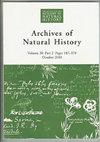Observations on Portuguese natural history by Leonhard Thurneysser zum Thurn (1531–1596), including the dyes derived from Kermes vermilio and Dracaena draco
IF 0.3
4区 哲学
Q3 HISTORY & PHILOSOPHY OF SCIENCE
引用次数: 0
Abstract
In 1555, Leonhard Thurneysser zum Thurn (1531–1596), a young apothecary, alchemist, astrologer and healer from Basle in Switzerland, travelled to Portugal and stayed in Lisbon with Damião de Góis (1502–1574), the Portuguese humanist and diplomat. The principal purpose of Thurneysser’s visit was the study of natural history and the observations and information that he collected then and during a second trip about 1562. These observations were recorded in a manuscript that remained unnoticed until the twenty first century. Thurneysser’s manuscript, now held in the Staatsbibliothek zu Berlin, contains descriptions of animals, plants and of two economically important dyestuffs, kermes and dragon’s blood, the first obtained from the scale insect, Kermes vermilio (associated with Quercus coccifera, kermes oak), and the second from Dracaena draco (dragon tree). Thurneysser’s contributions to knowledge of these two products and their associated plants were innovative and reveal an observer endowed with exceptional insight. His main sources of information, in addition to his personal fieldwork, observation of goods sold in Lisbon markets and conversations with vendors and merchants, were the classics of Antiquity and contemporary works including two of Damião de Góis’s works, Hispania (1542) and Urbis Olisiponis descriptio (1554).Leonhard Thurneysser zum Thurn(1531-1596)对葡萄牙自然史的观察,包括从朱红色和龙血树中提取的染料
1555年,来自瑞士巴塞尔的年轻药剂师、炼金术士、占星家和治疗师Leonhard Thurneysser zum Thurn(1531–1596)前往葡萄牙,与葡萄牙人文主义者和外交官Damião de Góis(1502–1574)一起住在里斯本。瑟内瑟此行的主要目的是研究自然历史以及他在1562年左右的第二次旅行中收集的观察和信息。这些观察结果被记录在一份手稿中,直到二十一世纪才被注意到。Thurneysser的手稿现在保存在柏林国家图书馆,其中包括对动物、植物和两种经济上重要的染料kermes和龙血的描述,第一种是从介壳虫kermes朱(与Quercus coccifera、kermes oak有关)获得的,第二种是从龙血树Dracaena draco(龙树)获得的。瑟内瑟对这两种产品及其相关植物的知识贡献是创新的,展现了一位具有非凡洞察力的观察者。除了个人实地考察、对里斯本市场上出售的商品的观察以及与小贩和商人的对话外,他的主要信息来源是古董和当代作品的经典,包括达米昂·德·戈伊斯的两部作品《伊斯帕尼亚》(1542年)和《乌尔比斯·奥利西波尼斯描述》(1554年)。
本文章由计算机程序翻译,如有差异,请以英文原文为准。
求助全文
约1分钟内获得全文
求助全文
来源期刊

Archives of Natural History
HISTORY & PHILOSOPHY OF SCIENCE-
CiteScore
0.40
自引率
50.00%
发文量
34
审稿时长
>12 weeks
期刊介绍:
Archives of Natural History (formerly the Journal of the Society for the Bibliography of Natural History) publishes peer-reviewed papers on the history and bibliography of natural history in its broadest sense, and in all periods and all cultures. This is taken to include botany, general biology, geology, palaeontology and zoology, the lives of naturalists, their publications, correspondence and collections, and the institutions and societies to which they belong. Bibliographical papers concerned with the study of rare books, manuscripts and illustrative material, and analytical and enumerative bibliographies are also published.
 求助内容:
求助内容: 应助结果提醒方式:
应助结果提醒方式:


